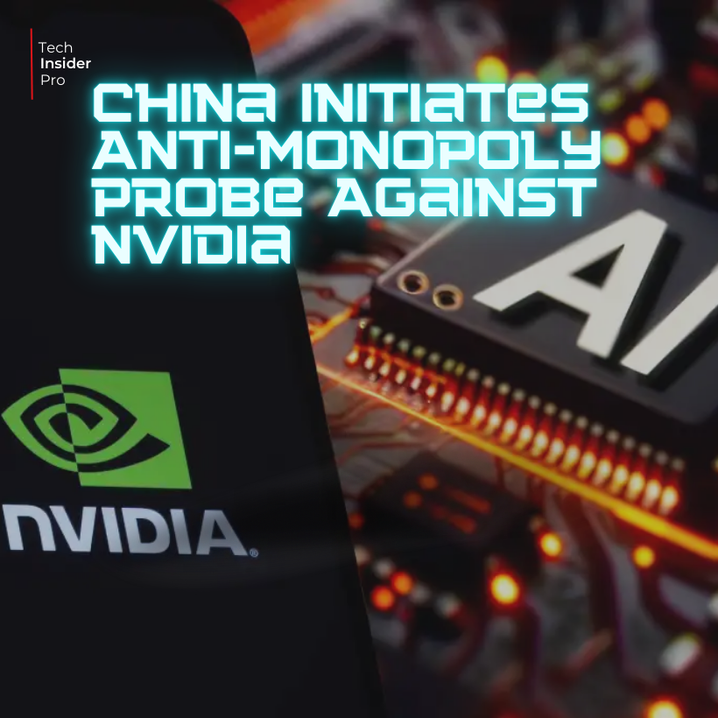
China recently shocked the IT industry by announcing an anti-monopoly investigation into Nvidia, one of the top pioneers in the development of graphics processing units (GPUs) and artificial intelligence (AI). Growing worries about market domination and competition in the semiconductor industry—a field essential to global technological advancements—are brought to light by this inquiry. The specifics of this probe, its effects on Nvidia, and its consequences for the larger IT ecosystem are all examined in this piece.
What is an Anti-Monopoly Probe?
Regulatory investigations known as anti-monopoly probes are designed to find and stop behaviors that could undermine market competition. These investigations usually center on businesses that are alleged to have engaged in unfair trade practices, abused their dominant market position, or erected obstacles to entry.
China’s increased monitoring of big businesses, especially international ones, in vital sectors like semiconductors and artificial intelligence is reflected in the country’s latest investigation into Nvidia. The action is a component of China’s larger initiatives to strengthen its domestic technological strengths and guarantee fair competition.
Nvidia: A Dominant Force in Technology
Global leader in semiconductor technology, Nvidia specializes in GPUs, which are essential for data centers, gaming, and artificial intelligence. Because of its technological innovations, the corporation is now a key player in a variety of industries, from healthcare research to driverless cars.
Important Revenue Streams and Markets
- Gaming: Millions of gamers across the world rely on Nvidia’s GPUs to power their high-performance visuals, and the company dominates the gaming market.
- AI and Machine Learning: Training machine learning models requires Nvidia’s AI chips, particularly its state-of-the-art H100 and A100 models.
- Data Centers: Nvidia’s GPUs are becoming essential for data center operations as cloud computing expands, greatly boosting the company’s earnings.
- Automotive Industry: Nvidia is essential to the development of AI systems for self-driving cars.
This dominance has positioned Nvidia as a critical player in global tech, but it has also raised concerns about its influence on the market.
Specifics of the Study
The focus of China’s anti-monopoly investigation into Nvidia is unfair business practices and market dominance. Regulatory bodies are probably investigating whether Nvidia has manipulated prices or used its dominating position to suppress competition, even though specific accusations have not been made public.
Events in Timeline
- Growing tensions within the semiconductor industry coincided with the announcement of the probe.
- China’s decision to take action may have been motivated by regulatory scrutiny of Nvidia’s acquisition attempts, including the unsuccessful attempt to acquire ARM.
Participating Agencies
The probe is being led by China’s top market watchdog, the State Administration for Market Regulation (SAMR). In an effort to preserve competitive fairness, SAMR has already targeted other tech behemoths.
Consequences for Nvidia
The investigation may have a significant impact on Nvidia’s business practices and expansion plans.
Impact on the Market and Finances
- Stock Volatility: Investor worries about possible regulatory penalties have already impacted Nvidia’s stock prices as a result of the probe’s news.
- Revenue Risks: One of Nvidia’s biggest markets is China. Any limitations or fines can have a big effect on business earnings.
Challenges in Operations
- In China, Nvidia can be subject to limitations on its distribution and pricing strategies.
- The inquiry may cause Nvidia’s regional projects—especially those pertaining to cloud computing and artificial intelligence—to be delayed or derailed.
The Regulatory Environment in China and Nvidia’s Function
China has tightened its regulations on both foreign and indigenous tech enterprises. This trend is a component of a larger plan to guarantee technological independence and keep foreign firms from displacing native firms.
Why Nvidia?
Nvidia is a prime target for examination because of its supremacy in semiconductors and artificial intelligence. Regulators’ fears were probably heightened by the company’s reliance on the Chinese market for sales and its control over vital technology.
China’s Overarching Objectives
- Encouraging Domestic Innovation: China wants to give domestic semiconductor companies greater space to expand by reducing Nvidia’s influence.
- National Security: Reducing reliance on foreign technology is a strategic aim for China, and semiconductors are essential for national security.
Effects on the World’s Technology Sector
The global tech industry and its competitive environment are impacted by the anti-monopoly investigation against Nvidia, which extends well beyond China.
The Semiconductor Sector
- Disruptions to the Supply Chain: Because of Nvidia’s crucial position in the semiconductor supply chain, any regulatory action might have an international impact.
- Opportunities for Competitors: If Nvidia is subject to limitations in the Chinese market, rivals like AMD and Intel might profit.
AI and Innovation
- Given that Nvidia’s chips are essential for training AI models, the probe may impede China’s progress in AI development.
- It calls into question how the tech industry strikes a balance between innovation and regulation on a worldwide basis.
Economic and Geopolitical Background
The investigation takes place against the backdrop of tense ties between the United States and China, especially in the areas of commerce and technology. This rivalry has centered on semiconductors, with both nations fighting for supremacy.
China-U.S. Tech Rivalry
- In an effort to restrict China’s access, the United States has placed export restrictions on cutting-edge semiconductor technology.
- China has responded by stepping up its attempts to create its own semiconductor capabilities.
Implications for International Trade
- The investigation emphasizes how difficult it is for international businesses to conduct business in China.
- It also emphasizes how important it is for businesses to diversify their markets and lessen their dependence on any one area.
Professional Views and Market Responses
Investors and industry analysts have had conflicting responses to the probe’s disclosure.
Industry Experts
- According to some commentators, China is using the probe as a strategic tool to level the playing field for domestic businesses.
- Some caution that such measures would discourage international investment in China.
Investor Attitude
- Some investors are cautious of the risks associated with regulatory obstacles, while others are still hopeful about Nvidia’s long-term potential.
Prospects for Nvidia’s Future
The investigation’s conclusion will have a significant impact on Nvidia’s future both domestically and internationally.
Possible Situations
- Regulatory Penalties: Nvidia may have to reconsider its approach in China if it is subject to fines or operational limitations.
- Better Compliance: Nvidia might take action to resolve legal issues and improve connections with Chinese regulators.
Techniques for Reducing Hazards
- Diversification is the process of entering new markets to lessen reliance on China.
- Cooperation: Working together with nearby businesses to overcome regulatory obstacles.
Innovation and Regulation in Balance
Important considerations of striking a balance between encouraging innovation and guaranteeing fair competition are brought up by the Nvidia investigation. Regulation must not hinder technical breakthroughs that benefit society, even while it is necessary to stop monopolistic practices.
Conclusion
The historic instance of China’s anti-monopoly investigation into Nvidia illustrates the increasing complexity of the global IT scene. The industry at large will be keenly observing Nvidia as it navigates this difficult time to comprehend the ramifications for foreign relations, competition, and innovation. The investigation’s findings will not only affect Nvidia’s future but also how governments around the world control technology in the years to come.






